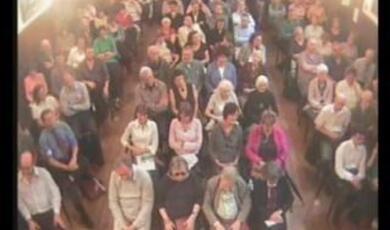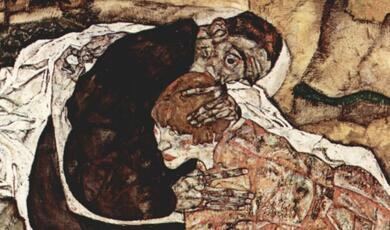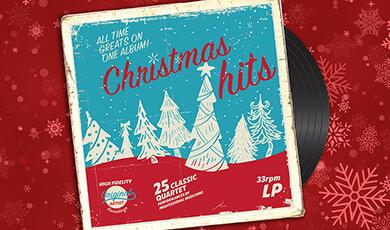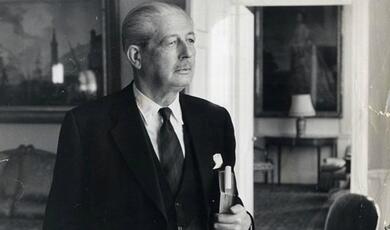Medieval Carols
Share
- Details
- Text
- Audio
- Downloads
- Extra Reading
From the first Christmas song by a 12th-century Northumbrian hermit, through the earliest surviving Christmas carol of the mid-14th-century, to the heyday of the carol in 15th-century England, Jeremy Summerly traces the early history of the world’s favourite musical genre with sung illustrations from the St Luke's Carollers of Chelsea.
Download Text
13 December 2016
Medieval Carols
Jeremy Summerly
The great flowering of the English vernacular carol occurred during the first half of the fifteenth century. One of the most intriguing of the early carollers was Blind John Audelay, an Augustinian friar with a colourful biography. Audelay’s Middle English is the dialect of North Staffordshire (technically the North West Midland division of the West Midland dialect). As a native of North Staffordshire, I would pronounce the surname of this blind lyric poet ‘Aid-lee’. John the Blind Audelay (that’s Aid-lee) was present at a murderous affray in the London church of St Dunstan-in-the-East in 1417. Audelay witnessed the fatal skirmish, whose protagonist was Audelay’s patron, Lord Richard Lestrange. Lestrange wounded another member of the nobility and a bystander was killed; all during the course of Easter Day worship. Audelay collected his writings together around the year 1426 – on his deathbed – at Haughmond Abbey, an Augustinian foundation near Shrewsbury in Shropshire. In 2012, Daniel Birkholz irreverently, but still respectfully, described Audelay as Deathbed John. I prefer to label him Ailing Audelay – my moniker at least homages medieval assonance. Audelay is associated with poetry that is arresting, if not great:
I pray yow, syrus, boothe moore & las, I pray you, sirs, both more and less,
Syng these carols in cristemas. Sing these carols in Christ-e-mas.
This couplet heads the carol section of Audelay’s manuscript, and I’m bound to say that it is invested with lilting charm when rendered in a Potteries’ accent.
Audelay’s carols are preserved in a parchment manuscript kept in the Bodelian Library in Oxford as Douce 302. Francis Douce (1757 - 1834) was an antiquarian who amassed an enormous private collection of books, manuscripts, prints, and drawings. For three years, Douce had been Keeper of Manuscripts at the British Museum in London, and it’s to that institution that Douce might have been expected to leave his materials. But Douce was flattered that the Bodleian offered to append his name to the collection in perpetuity. So Douce left the Oxford library almost twenty thousand printed books and 420 manuscripts. Douce 302 contains fifty-five poems by Audelay, twenty-five of which are labelled caroles. Apart from writing his own carols, John Audelay knew ‘Angelus ad virginem’, which he translated as ‘The angel to the vergyn said’. Audelay was clearly not writing his English translation of ‘Angelus ad virginem’ to the well-known version of the melody – his translation just doesn’t fit. Indeed he may not have been making his translation to be sung at all. When the Latin phrase ‘tu porta coeli facta’ (near the end of the first verse) is translated as ‘he will make thee the gate of heaven bright’ (ten syllables rather than seven), then the extent of Audelay’s musical sensitivity looks meagre. Neither is it clear why Audelay left out the crucial third verse, where Mary says that she’s ready to obey God’s will.
Of the twenty-five carols in Audelay’s collection, a dozen are relevant to Christmastide, of which seven specifically cover the feasts celebrated on 25 to 29 December inclusive, and 1 and 6 January. A further carol is in honour of St Francis. Although Audelay was an Augustinian rather than a Franciscan, he would have had great respect for St Francis. Not least because Francis was crucial to the creation of vernacular Christian song.
Audelay’s carol for Christmas Day (‘In die natalis Domini’ – ‘On the day of the birth of the Lord’) is one of six carols in Audelay’s collection that are preserved in sources other than Douce 302. In general, the variants in the versions preserved in the other sources are minor ones. But in the case of Audelay’s Christmas Day carol, the version in Douce 302 differs significantly from the carol as it appears in the British Library’s manuscript Sloane 2593. Sloane 2593 is an early-fifteenth century paper manuscript of thirty-seven leaves (part of a missing larger volume) that originally hails from Bury St Edmunds in Suffolk. It seems that the Bury version and Audelay’s version have a common ancestor. In other words, the Christmas Day carol is an Audelay adaptation rather than an Audelay composition. The Bury St Edmunds version has become better known as the text of the second movement of Benjamin Britten’s A Ceremony of Carols. In 1942, Britten left America after a period of self-imposed exile. Homesick, he returned to England to face a conscientious objectors’ tribunal. On the long transatlantic voyage home, Britten wrote two choral works, one of which was A Ceremony of Carols for harp and upper voices. After the plainchant procession at the piece’s opening, the singers exclaim ‘Wolcom Yole!’ (‘Welcome, Yule!’). To the left is the poem as Britten sets it (taken from the Bury source) and to the right is Audelay’s version:
Wolcum be thou hevenè king, Welcum be thou heven kyng
Wolcum, born in one morning, Welcum ibore in hon mornyng
Wolcum for whom we sall sing! Welcum to the now wil we syng
The versions are so similar that there can be no doubt that the two carols derive from the same source. But the second verse of Audelay’s version is specific to the blind poet’s version; to the left Audelay, to the right in modern English:
Welcum be thou mare myld Welcome be thou, Mary mild,
Welcum be thou & thi child Welcome be thou and thy child,
Welcum fro the fynd thou us schilde Welcome, from the fiend thou us shield:
Welcum yole fore & ever & ay Welcome, Yule, for ever and aye!
Welcum yole in good aray Welcome, Yule, in good array,
In worchip of the holeday In worship of the holiday!
Another of Audelay’s carols has concordances in two other sources – the Bury St Edmunds manuscript and a manuscript compiled a century later by a London grocer called Richard Hill. This carol is labelled by Audelay ‘In die Epephanis etc.’ (‘On the day of Epiphany etc.’). The Epiphany Carol is unique in Audelay’s collection in that its burden comprises a single line (not two as elsewhere) and the burden doesn’t rhyme with the end of the verses. Indeed, the burden is just three statements of the word Nowell. Here is the second verse, with a halting modern version to the right:
In bedlem in that fayre plas In Bethlem, in that fair place,
this blessid barne borne he was This blessed bairn, born he was,
him to serve god grawnt us grace Him to serve, God grant us grace,
tu trinetatis unitas Tu Trinitatis Unitas [You, the Unity of the Trinity].
Nowel nowel nowel Nowell, Nowell, Nowell!
John the Blind Audelay is crucial to the history of the medieval carol. Blind (and by the end of his life also deaf), as Ailing Audelay approached death in the mid-1420s, he left for posterity the first manuscript in which carols were presented in a coherent order. And his collection showed that Christmastide was becoming important subject matter for the carol. But Audelay left us no music; just words.
125 fifteenth-century carols survive with music and the majority are in triple metre. About three-quarters of the carols are appropriate to Christmas, and all but ten are for two or three voices. The most characteristic form is where two voices sing the stanzas and three voices sing the burden. Some of these carols have a second burden. Where this is the case, the first burden tends to be set for just two voices, and the second burden for three voices. In certain cases this second burden is marked ‘chorus’. So there was an explicit demarcation between florid music that was designed to be sung by flexible solo voices, and a fuller musical refrain sung by many. This opens the door to the increased sophistication of choral performance of all subsequent part-music. It would be over-stating the case to claim that without the choral innovation of the fifteenth-century English carol there would be no Ninth Symphony of Beethoven; but only slightly. Moreover, the fifteenth-century carol repertory contains some extremely beautiful music. It is music whose mesmeric, ephemerally consonant style accords extremely well with our listening tastes of today.
The only named composers of the fifteenth-century carol are Childe (one carol), Richard Smert (c1400-c1479; seven carols), and John Trouluffe (died 1473; four carols written jointly with Smert). Smart, Child & Truelove: purveyors of the late-medieval carol. Four major sources of the fifteenth-century carol survive and all of them transmit both music and words. The labels ‘Trinity Roll’, ‘Selden B26’, ‘Egerton 3307’, and ‘Ritson MS’ are cat-nip to musical antiquarians. The provenance of each source is uncertain, but they all seem to have been copied in the central fifty years of the fifteenth century. They probably originated in East Anglia, Windsor, Worcester, and Devon respectively.
The Trinity Roll is the oldest and most quirky of the fifteenth-century carol sources. It could have been copied at the collegiate church of Mettingham, a village whose name comprises three Anglo-Saxon words meaning ‘dwelling-place near low meadows’. Mettingham is in east Suffolk, near the River Waveney, on the Norfolk border. Housed in the library of Trinity College, Cambridge since 1838, with the shelfmark O.3.58, this vellum manuscript is a (sc)roll of three laced-together sections measuring over six-and-a-half feet long. The roll, whose format was familiar within legal and administrative circles, was copied as an exemplar from which other copies could be made. Rolls were easy to transport, and adequately protected their contents for the relatively short period during which they were passed from scribe to scribe. What is remarkable is that the Trinity Roll should have survived at all given that it wasn’t designed for long-term use. Thirteen fine carols, all written out in the same hand, are buried in this national treasure. Sheep were plentiful in fifteenth-century Suffolk, but the ovine membranes that form this document were still valuable. So a yard of the roll’s back was later re-used as material on which to write the words of some spoken sections of Roman Catholic services. In 1891, transcriptions of the carols written on the Trinity Roll were lavishly published by John Fuller-Maitland (1856 - 1936). Fuller-Maitland had been an undergraduate at Trinity College in the 1870s and became a forceful and opinionated critic and scholar. He was chief music critic of The Times from 1889 to 1911. The composer Sir Arthur Sullivan (1842 - 1900) had reservations about Fuller-Maitland’s critical judgement on the grounds that he was ‘a dangerous man, who admires Brahms and Wagner’.
John Fuller-Maitland made a so-called ‘diplomatic’ transcription of the carols of the Trinity Roll; that’s to say he used the typographical technology of his day to emulate the original notation. This was a half-way house, which conveyed the appearance of the original notation, but it didn’t make the music approachable to the non-specialist. Because of that, Fuller-Maitland followed his diplomatic transcription with a modern transcription of the carols. So far so good, except that Fuller-Maitland engaged his friend and former teacher William Rockstro (1823 - 95) to add extra voice parts to all of the carols (in particular, a newly-composed Bass line to each). The plangent medieval harmonies of the Trinity Roll were brought bang up to date in late-Victorian manner. The effect might be like an eighteenth-century architect slapping a pair of towers onto a gothic masterpiece, except that Nicholas Hawksmoor’s iconic West Towers of Westminster Abbey are stylistically harmonious, whereas Rokstro’s Victorianization of the Trinity Roll is harmonically counter-productive. Indeed, Fuller-Maitland’s most useful contribution to our appreciation of the Trinity Roll is the frontispiece of the edition, which is a facsimile of the seventh carol in the collection. I remember gazing in awe at this beautiful reproduction when I was a postgraduate student. It was a Damascene experience. Here’s what I saw. In timeworn brown-hued ink, the laterally compressed diamond noteheads, with their proud stems and emolliently busy hooks, snake across the grids of the five-line staves. These agile symbols are visibly breaking out of the constraints of brittle medieval accidence as they propel themselves into a humanistic soundworld of controlled dissonance. The notes perch legibly on supportively understated soft-red staves, the whole underlaid by a careful late-Anglicana, now-sepia script, sparingly peppered with small but striking alternating red and blue upper-case letters. These colourful initials mark the start of the burden and each of the carol’s five stanzas. This is the famous Agincourt Carol:
Our kyng went forth to normundy Our King [Henry V] went forth to Normandy
with grace and myth of chivalry… with grace and might of chivalry…
Ther lordys eerlys and baroun There Lords, Earls, and Barons
were slayn and takyn and that ful soun… were slain and taken, and that full soon…
Deo gratias, Anglia, redde pro Victoria. Give thanks to God, England, for victory.
The music of this immensely powerful carol was used to great effect by the composer William Walton (1902 - 83) in his music for Laurence Olivier’s 1944 film Henry V.
The poetic form of the fifteenth-century carol is variable, but the most common is where the stanzas comprise four lines, the first three of which rhyme with each other, and the fourth of which rhymes with part of the following burden (this fourth line was known by the Latin word ‘cauda’ – ‘tail’ – and the burden was known as the ‘foot’). This is a fabulously pragmatic scheme, since the change of rhyme at the end of the stanza not only cues the chorus for its rendition of the burden, but it does so in integrated sonic manner. When that fourth line is in Latin and links to an ecstatic Latin burden, the form is well-nigh perfect:
a, a, a, a, Ay, ay, ay ay,
nunc gaudet maria Now Mary rejoices.
mary is so fayr of face Mary is so fair of face,
and here sone so ful of grace And her son so full of grace;
in hevene he make us a place In heav’n he make us a place,
cum sua potencia With his power.
a, a, a, a, Ay, ay, ay ay,
nunc gaudet maria Now Mary rejoices.
Selden B26 is so-called because it is catalogued as Archivum Seldenianum b.26 in Oxford’s Bodleian Library. John Selden (1584 - 1654) left his library to the Bodleian, although some shoddy drafting meant that there was a legal wrangle that lasted almost five years before the books arrived in the library’s West End (subsequently known as the Selden End). Transporting, housing, and securing Selden’s library was a costly business, so costly indeed that Oxford University’s Convocation had to levy a special tax to cover those costs, and even undergraduate students had to shell out a shilling each (a not insignificant amount in 1659). Fortunately for us, Selden’s library has been lovingly cared for ever since, and Arch. Seld. b.26 is one of the jewels in the Bodleian’s musical crown. Selden B26 comprises several early manuscripts bound together at the Restoration, and the carol section alone showcases nine different text hands and eleven different music hands. And it is the earliest manuscript explicitly to direct the involvement of a ‘chorus’. In 1901, all of the carols within B26 were presented in facsimile and transcribed by Sir John Stainer (1840 - 1901), Professor of Music at Oxford University. The two-volume Early Bodleian Music is evidence of Stainer’s visionary and methodical musical mind. He may now be considered a minor composer, but Stainer’s influence on British musical culture in the second half of the nineteenth century and beyond was significant.
Selden B26 also contains a version of the Agincourt Carol, and it is from B26 – at one stage removed – that the pioneering musicologist, John Stafford Smith (1750 - 1836), made his very early transcription. If the name John Stafford Smith seems familiar, it will be because he wrote the music now used for ‘The Star-Spangled Banner’, the national anthem of the USA. Published in 1779, Stafford Smith’s A Collection of English Songs contains a transcription of the Agincourt Carol made from another transcription in the Pepys Library in Magdalene College, Cambridge. This meta-transcription is notationally dodgy. But the principle of showing a diplomatic transcription opposite a modern one was worthy, and it forged the way for Fuller Maitland’s effort over a century later. Moreover, the music (however inaccurately transcribed) was left to speak for itself rather than subjected to so-called harmonic improvement. Georgian sensitivities to the treatment of early music outstripped Victorian ones in this case.
Egerton 3307 opens with a selection of music for Holy Week and the second part includes thirty-three carols. Twenty of the carols are in Latin (the last of which is incomplete), five are in English, six are in a mixture of Latin and English, and one is in three languages (four if you count the Greek word ‘alpha’ in the closing phrase of its first verse). A further carol in the Egerton manuscript is textless, which might – on the face of it – suggest that it was for instrumental performance. However, the form and style are so similar to that of the other carols in the collection that it seems more likely that this was a draft by a second scribe who never finished the job. Indeed, as well as not writing the words beneath the notes, the scribe also didn’t colour in some of the noteheads which would properly have indicated duple inflexion within an overriding triple metre. So Scribe B was either not very musical, or – more likely – was caught short.
The Ritson Manuscript comprises twenty-two paper folios and is housed in the British Library as Additional Manuscript 5665. It was donated to the British Library on 7 August 1795 by the bad-tempered Westmorland-born antiquary Joseph Ritson (a contraction of Richardson). Eight years after his timely donation, Ritson became insane, made a bonfire of other valuable manuscripts, and died. In the year of his death, Ritson was described by the poet (laureate-to-be) Robert Southey to another of the Lakeland Poets, Samuel Taylor Coleridge, as ‘the oddest, but most honest of our antiquarians’. Indeed, the lover of the late-medieval carol owes a great debt of gratitude to Joe Ritson, since the survival of fully one third of the extant fifteenth-century carol repertory with music is due to his vigilance. That’s particularly remarkable, given that this contrary but enlightened eighteenth-century figure maintained that he lived in ‘total ignorance of the musical art’.
The most colourful carol in the Ritson Manuscript is ‘Nowell, nowell – This boar’s head’. This carol is by Richard Smert and is known as the Exeter Boar’s Head Carol because of the Ritson Manuscript’s assumed Devonian provenance, and to distinguish it from other Boar’s Head carols. Smert was a singer at Exeter Cathedral, but this carol was clearly intended for the refectory and not the chancel:
Nowell nowell nowell nowell Nowell, nowell, nowell, nowell:
tydynges gode y thyngke to telle tidings good I think to tell.
This borys hede we bryng with song This boar’s head we bring with song
in worchyp of hym that thus sprang in worship of him that thus sprang
of a virgine to redresse all wrong of a virgin to redress all wrong:
nowell nowell Nowell, nowell.
The very last word there is set for three solo voices rather than two. And the burden (shown above in italic) has a two-voice (duet) version and a three-voice (chorus) version. This is especially informative because it shows a number of compositional features. First, how a tune may adapt its ending to finish in one key or another. Secondly, how a third voice may be added to two pre-existent voices in a consonant manner while also subtly altering the harmony. Thirdly, how much the composer is enjoying the richness of triadic writing for three voices – a craft whose effect is heightened by choral rather than solo treatment.
A feature of the late-medieval English carol repertory is that some of the items have bits of Latin text woven into the English narrative. These so-called macaronic carols lift Latin tags from the liturgy. Phrases like: ‘angeli canunt’ – ‘angels sing’; ‘puer natus’ – ‘a new-born boy’; ‘jacentem in praesepio’ – ‘lying in a manger’; and ‘laus, honor, virtus, gloria’ – ‘praise, honour, virtue, glory’ appear within predominantly English texts. In doing so these Latin interpolations lend gravitas (note my use of a Latin word) to the verbiage and invest it with authority (three more Latin-derived words to do exactly that). That these carols are found in sources alongside liturgical material seems to indicate a close connection to the church, although the material wasn’t designed for use in church services. The Latin drinking song, which appears interspersed with the carols in Egerton 3307 might offer a clue to the performance arena of the fifteenth-century carol – around the fireside or in the dining hall, perhaps.
The fifteenth-century carol repertory was of a time and of a place. Late-medieval England witnessed the emergence of a new breed of church musician. The career path of this new type of singer was a specifically musical one, and not a series of steps up the clerical ladder, as previously. This new generation of portfolio musician not only sang, but also composed, copied out music, played the organ, and taught the choristers. It’s not surprising that these career musicians developed a repertory outside the liturgy. Their leisure music was designed for amusement and personal development within a salaried environment, but not for formal use there. If the fifteenth-century carol was used in the refectory, out in the cloister, or by the hearth, the church authorities can only have taken pride in the members of their musical establishment who chose to exercise their intellect and vocal agility in such a manner. In the words of musicologist Roger Bowers writing in 1981, the church authorities acted ‘in a spirit of benign abstention’: micromanagers, it seems, they were not.
While the fifteenth-century carol repertory wasn’t designed for use within church services, it’s conceivable that a carol with, say, a Christmas text might have been heard before or after formal worship, perhaps from the respectful distance of the narthex or ante-chapel. The important point is that composers of the early carol were employed as performers. Many of them would have developed an interest in composition, and the carol was the domestic genre that they could use in order to flex their compositional muscles. The craft of manipulating melody, harmony, and rhythm is readily learnt when a group of composers themselves create the medium and choose their own texts. These were the most sophisticated musicians in the land – a land where the ability to manipulate mensural (measured) musical notation fluently was possessed by only a few hundred people. And in the carol, these composers were to be found creating music on their own terms. That this kind of technical and artistic indulgence might help them to compose effectively for the liturgy was grist to the mill of the church establishment. The composition of carols fulfilled an educational and self-promotional need for the composers themselves. And a pragmatically supportive senior management team would surely bathe in the reflected glory of a group of employees who took responsibility for their own professional development, the product of which was sensorily stimulating and, frequently, spiritually uplifting into the bargain. In 1950, the German-born American musicologist Manfred Bukofzer described these carols as ‘art music in the popular vein’. This echoes Richard Leighton Greene’s memorable 1935 description of this music as ‘popular by destination’ rather than ‘popular by origin’. Peter Lefferts, writing in 2011, believed that this English carol repertory was designed
for recreational use at Christmas and Eastertime in the world of the scholars, fellows and singing-men of schools, colleges and major ecclesiastical choral establishments.
These carols were disseminated in writing and not by oral transmission. And they were meant to be enjoyed by those taking part. This was chamber music. To be sure it was edifying music, but it was music whose performance was to be relished by its participants. Its participants were also its audience.
© Jeremy Summerly, 2016
Part of:
This event was on Tue, 13 Dec 2016
Support Gresham
Gresham College has offered an outstanding education to the public free of charge for over 400 years. Today, Gresham College plays an important role in fostering a love of learning and a greater understanding of ourselves and the world around us. Your donation will help to widen our reach and to broaden our audience, allowing more people to benefit from a high-quality education from some of the brightest minds.


 Login
Login







